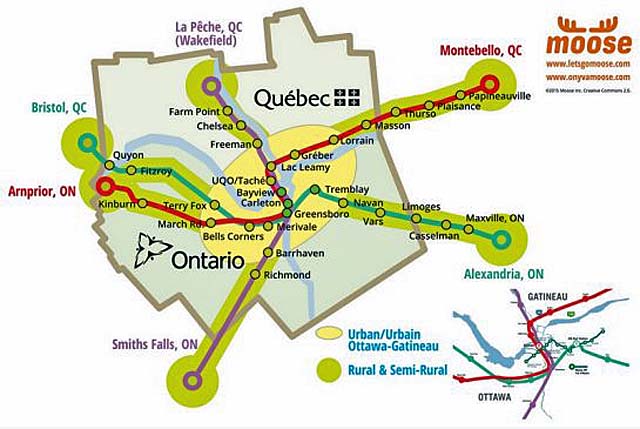

of Rail in Rural Quebec
Ottawa Ontario - Another dispute over the removal of railway tracks has led the MOOSE Consortium to ask the Canadian Transportation Agency (CTA)
to order the town of Chelsea, Quebec, not to rip up a 20 kilometre section of track that the town intends to replace with a regional bike path.
The MOOSE Consortium filed an official complaint on Monday with the CTA asking them to block Chelsea from beginning work to remove the track.
They are making an ambitious claim, track that has been considered provincial domain for decades is in fact federal track, based on two acts of Parliament from
1887 and 1894, and some ambiguous decisions from the 1980s.
MOOSE director Joseph Potvin admits it's a lofty goal.
"Everybody can assume that the sky is tangerine coloured," he said.
"If it's actually blue, I can declare it's blue, and see what the court says."
He added, though, that he is optimistic about his case, "we're batting seventy-five," he said, referring to past court challenges.
Chelsea Mayor Caryl Green says that their council has already decided to take a pass on Joseph Potvin's MOOSE rail network.
"We just don't have the density to support a light rail," she said.
The proposed trail "can link many neighbourhoods along the length of our municipality."
In all likelihood, this is all the same to Potvin and MOOSE, Wakefield, the only town further north on the line than Chelsea, withdrew their support for the
project back in May, according to Green.
Part of Potvin's argument is that the City of Ottawa has already landed itself in hot water for hastily removing track, and blocking Chelsea from doing the
same may save future headaches.
"If the Municipality of Chelsea is permitted to dismantle the Maniwaki Subdivision (ie., the rail in question) within its territory at the same time as
the merits of this present complaint are being considered by the Agency," writes MOOSE, "then the Agency may again find itself exercising its
authority only after irreparable harm is done, as recently occurred involving the City of Ottawa."
This speaks to one of the challenges that MOOSE is facing with its project, their plan depends heavily on access to rail lines that are either in poor shape or
remain in jurisdictional limbo, it is not often, after all, that one must dig up Acts of Parliament from the 19th century in order to secure the rights to
build a transit service.
This is a challenge both bureaucratic and physical, as well.
Removal of the actual rails would likely be necessary in any case, to update it to modern specs, but to change the use of the corridor would be to effectively
cut off the area from the Capital region by rail indefinitely, since there is currently no other way to connect the two areas.
It's another front in a war that MOOSE is waging with municipalities throughout the National Capital Region.
MOOSE is engaged in a similar conflict with the City of Ottawa, claiming that the city did not properly follow discontinuance processes when they ripped up 240
metres of track near the Princess of Wales Bridge.
In Ottawa, it seems more clear-cut that discontinuance rules were not properly followed, as the CTA has seemed to side with MOOSE in their
complaints.
There is opposition beyond MOOSE, as well.
"There's been no true public consultation," said Tim Kehoe, former Ottawa city councillor and chair of the Chelsea Communities Preservation
Association (CCPA).
"The only opportunity we've had to learn were two information meetings, more than a year ago."
Kehoe, whose house backs onto the rail corridor, says that the out-of-use railway already functions as a walking and cross-country skiing path, and most
residents with homes along the rail line oppose the plan.
Moreover, since the corridor was used for over 100 years as a steam train corridor, environmental contamination poses a problem, says Kehoe.
Though an environmental assessment is still ongoing, Chelsea has signalled that it intends to remove the track as soon as it can secure a
contractor.
Kehoe says that an environmental study is ongoing, and beginning to rip up the rails and level the land is a mistake until that study determines it will be
safe.
"It's not as if it's a gut hunch we've got," says Kehoe.
"It's a well-known, well-established set of facts, that the whole rail line is contaminated."
Kehoe, who sought the original injunction to halt demolition of the rail corridor that was struck down last Friday, says he and the CCPA are considering their
options.
"One of those is an appeal," he says.
"There's two ways we can go with this. We can go legally, or we can go through direct communication and negotiation."
Kehoe says that, at the moment, both options are being considered, but nothing has been finalized.
Author unknown.
of the Canadian Copyright Modernization Act.


